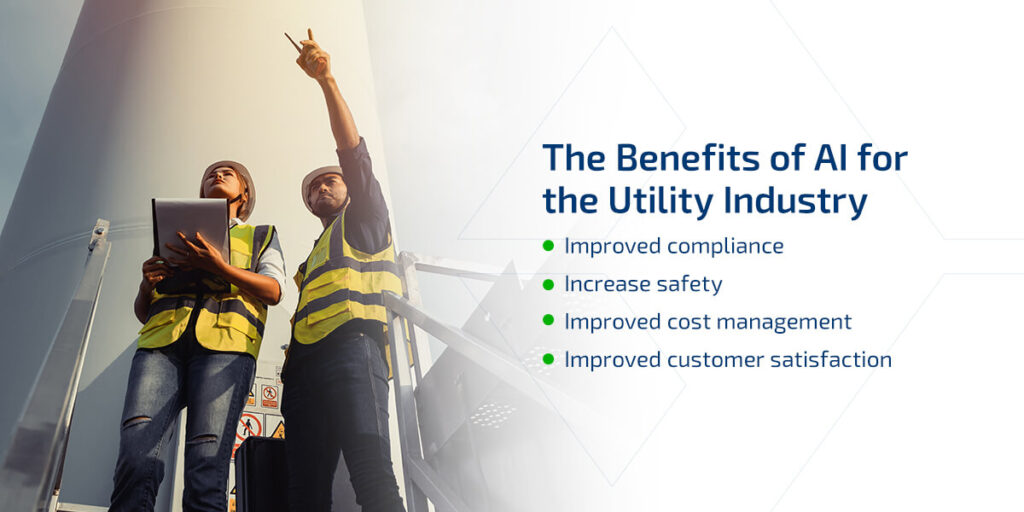Utility companies often experience challenges detecting defects in their equipment, wiring and pipes. These companies are also under immense pressure with the aging workforce and assets and high volumes of data. Machine learning in risk management can use historical and current data to create analytics models that inform predictive maintenance tasks. Predictive analytics can help utility companies make informed decisions about their asset health to improve performance, predict failures and reduce overall maintenance costs.
Increasing demand, customer expectations and safety concerns force utility companies to adopt new solutions to address these challenges. Many solutions exist within company data, but humans cannot sort through so much information. Artificial intelligence (AI) and machine learning technology can help utility companies make sense of their data and find practical solutions to protect their assets and ensure their customers receive reliable service.
Artificial intelligence in energy and utilities has numerous applications, including predicting maintenance requirements and outages. With proper implementation, AI can revolutionize the utility industry.

How Is Artificial Intelligence Used in Energy and Utilities?
AI in utilities addresses numerous challenges, including managing customer needs and making their services efficient. Some of the ways machine learning is used in the energy sector include the following:
Energy theft is one of the most expensive challenges for utility companies as modern metering technology advances. Energy theft can cause significant damage to the power grid, which can reduce operating profits and power supply quality. AI is used in public utilities to provide real-time information on energy loss, using customers’ historical energy consumption to predict their future usage. AI can help detect energy theft by detecting abnormalities in consumers’ historic and current use, making it easier for utility companies to address these problems before they become a significant concern.
AI can help utility companies collect real-time data to detect different areas for optimization. Monitoring and visualization can collect data correlating to activity rate, time and the state of specific operations. Machine-learning technology can analyze data to improve productivity, ensure compliance with regulations, reduce costs and develop an understanding of a customer’s utility use. The availability of accurate, timely data also informs utility companies’ decisions so they can deliver cost-effective and safe operations that benefit the consumer.
AI can be used to predict outages, which can be costly and disruptive to the power supply. AI can predict where power outages are likely to occur, which helps utility companies take steps to prevent them. The ability to anticipate and address outages can be a massive step forward for utility companies in taking care of their customers.
Additionally, AI can also transform the customer experience. AI can help utility companies predict energy, water and heating consumption and develop dynamic pricing to offer lower prices to consumers when there are excess resources.
AI can also create a personalized view of appliance usage that customers can use to adjust and regulate their resource consumption. Utility companies can use AI to recommend the best times for customers to use their resources to help them save on costs.
The Benefits of AI for the Utility Industry
AI can review data and learn from previous outcomes, helping utility companies find cost-effective solutions for risk management.
AI can develop accurate insights and predictions that let utility companies identify areas with the most significant risk and plan maintenance and shutdowns. Some of the notable benefits of AI for the utility industry include the following:
- Improved compliance: AI can collect data that utility companies can use to ensure they’re meeting compliance reporting requirements aligned with regulatory guidelines.
- Increase safety: AI can help utility companies identify and repair potential safety hazards before they can cause damage and place local communities at risk.
- Improved cost management: AI and machine learning technology can save on maintenance reports, manual inspections and other tasks typically performed by human employees.
- Improved customer satisfaction: AI can help utility companies prevent outages, boosting customer satisfaction and making them more loyal to your business.

The Challenges of Implementing AI and Machine Learning
While digital transformations and AI has many benefits for utility companies, they can also be challenging. Some of these challenges include the following:
- Cautious approaches to digital solutions: Some utility companies are careful about adopting digital solutions to address their challenges. This cautious approach makes it more likely for AI and machine learning implementation to fail, especially if these systems are implemented incorrectly or too slowly, and companies don’t see the results they expect.
- Difficulty attracting talent for digital roles: Implementing AI and machine learning technology requires employees with the proper technical skills to operate the equipment. However, attracting talent for digital roles in utilities can be challenging since AI is becoming popular across numerous industries, lessening the pool of potential candidates. Competitive rates in other industries also contribute to difficulty attracting talent for digital roles.
- Complex legacy operations and IT environments: Many utility companies have operated for decades and have established operations and IT environments. Integrating AI and machine learning technology with these legacy systems without the proper technical skill can be difficult and hinder utility companies from implementing this technology.
While these challenges can be a barrier for some utility companies, certain solutions can make it easier for companies to adopt this tech. Being open to this new technology and offering incentives to attract talent can make it easier to implement AI and machine learning solutions into legacy operations and complex IT environments.
Using Machine Learning to Manage Critical Assets
AI and machine learning technology can help utility companies manage their critical assets. AI can intake large amounts of data, including installation dates, brands, suppliers, maintenance records, weather conditions and historical failure records. Analyzing this information can help determine when equipment is at a higher risk of failure. Some of the ways you can use machine learning to manage your critical assets include the following:
- Hazard identification: Machine learning technology can quickly identify hazards with your equipment assets. AI can analyze thousands of hours of data so human intervention teams can examine the problem and respond.
- Weather-related outage and demand predictions: AI can analyze historical weather data and usage patterns to determine what weather conditions will likely cause outages and when. This data can inform maintenance and response to reduce the risk of asset damage and ensure consumers get reliable utilities during extreme weather conditions.
- Grid safety precautions: During some weather events, it can be necessary to shut down parts of the grid for safety. AI technology can provide quick insight to identify areas at the highest risk so energy companies can plan shutdowns.
- Asset risk identification: Identifying asset risks is essential for overall safety, but monitoring every piece of equipment lies beyond the scope of human workers. AI and machine learning technology can help identify risks to help utility companies reduce failures and inspection costs.
Leverage Artificial Intelligence With TRC Companies
TRC Companies can help you integrate AI technology into your utility business to ensure you can keep up with the rapid changes in the industry. Digitalization is likely essential for the future of the electric industry, making it critical to implement AI and machine learning technology to increase efficiency and keep costs low.
TRC Companies can help you use AI to drive insights to inform your business practices, from customer usage to asset maintenance. Our technology partners and expertise in utility networks can help you revolutionize how you do business. Contact us today to learn how we can help you take advantage of AI in the utility industry.





















